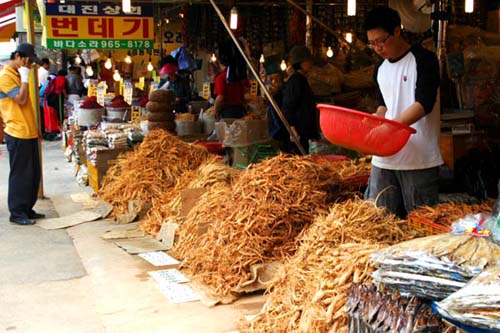Ginseng in Korea

One thing you might notice rather quickly after arriving in Korea is the bounty of ginseng available seemingly everywhere. Dried ginseng leaves have found their way into many popular teas across North America and experienced quite a boom. In this form the effects of ginseng are considerably milder, and it is certainly a much watered-down experience of the root. If you find yourself traveling in the region, or enlisting in the great ESL army in South Korea, it would be foolish not to experience this root that has come to be such a staple of the area.
Over 80% of the ginseng supplied throughout the country comes from Seoul’s Gyeongdong Market. This medicinal market is home to endless rows of ginseng vendors. Huge piles of the roots are heaped on tarps on the floors and overflow from carts, crates, and bushels. Leisurely shoppers will come away smiling with a bulging sack full of ginseng for around 5,000won (at time of posting, roughly US$4). You don’t have to make the trip to Gyeongdong to find ginseng, however. The roots can be found in every grocery market big and small, and even the tiny corner convenience stores throughout the country.
Ginseng is ubiquitous in Korea and as such the root has been put to great use. Fresh ginseng is grated and thrown into many dishes or simply chopped and chewed as a dietary supplement. There are soft drinks containing ginseng and even ginseng wine in both red and white and made from several different classifications of the root (the wine has a strong alcohol flavor however, wine enthusiasts beware).
The root has many medicinal functions, and is kindly thought of as the “heal-all” plant. Ginseng is known to combat stress, and is used for a myriad of purposes including: as an antioxidant, stimulant, aphrodisiac, and to improve blood circulation and combat erectile dysfunction. Considering its reputation as a reliable natural stimulant, I recommend shaving the stuff down and tossing it into your coffee press or tea cup to ward off traveler’s exhaustion, or merely to keep you energized throughout your busy days.
Several different classifications of the root are easily found throughout Korea. Fresh ginseng, the raw stuff that you pull from the ground, abounds everywhere. One will also find white ginseng, which is more of a yellowish color, that is pealed and left to dry naturally in mild sunlight, and red ginseng, which is boiled and dries to a rich brown color. Throughout North America and other parts of the world, wild ginseng has become a more expensive commodity as demand for the stuff increases. However, in Korea, the wild root is still plentiful enough that prices remain comparatively low.

June 16th, 2010 at 10:13 am
Ginseng is very popular in the U.S. Go to any Whole Food Market and you’ll find a plethora of teas with ginseng in them. Of course, you can’t forget about the health stores like GNC and others that sell the supplements. Never heard of ginseng wine. How does it taste?
June 16th, 2010 at 6:20 pm
Right, though most of the tea bags on your grocer’s shelves carry a very mild form of ginseng. Some of the ground leaves of the plant are thrown in with a lot of filler – mostly black or green tea leaves. It’s not the best way to get your ginseng. You’re much better off going with the supplements or oil in this case. Ginseng root still remains more expensive and harder to find in the States. It’s wonderful that Korea is just bursting with Ginseng root.
Ginseng wine has carries a distinct alcohol taste. It is definitely more reminiscent of vodka than any kind of wine. It is certainly to be tried, but it’s not something you want to sip all evening long.
🙂